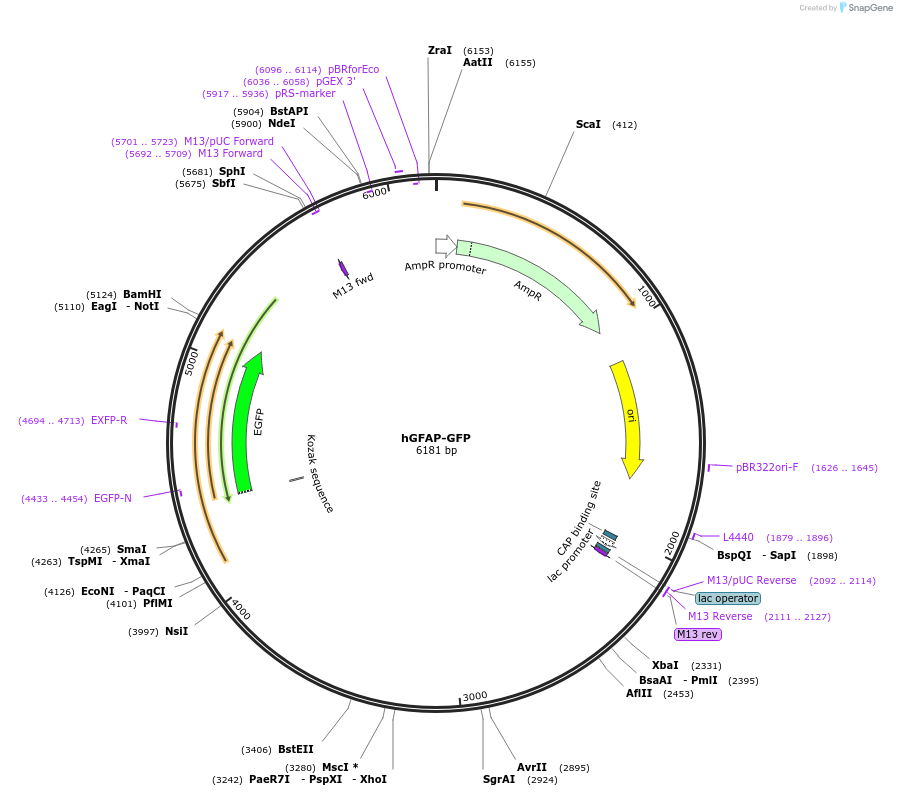-
Depositing Lab
-
Publication
-
Sequence Information
Ordering
| Item | Catalog # | Description | Quantity | Price (USD) | |
|---|---|---|---|---|---|
| Plasmid | 40592 | Standard format: Plasmid sent in bacteria as agar stab | 1 | $89 | |
Backbone
-
Vector backbonepgfa2-lac2
-
Backbone manufacturerMichael Brenner (PMID: 7952266)
- Backbone size w/o insert (bp) 5500
- Total vector size (bp) 6250
-
Modifications to backboneLacZ coding region of pgfa2-lac2 replaced by a mutated, humanized hGFP(S65T) cDNA.
-
Vector typeMammalian Expression, Bacterial Expression, Mouse Targeting
Growth in Bacteria
-
Bacterial Resistance(s)Ampicillin, 100 μg/mL
-
Growth Temperature37°C
-
Growth Strain(s)XL1 Blue
-
Copy numberUnknown
Gene/Insert
-
Gene/Insert nameGFP-S65T
-
Alt namehGFP-S65T
-
Alt nameGFP
-
Alt nameTg94.7
-
SpeciesH. sapiens (human), M. musculus (mouse), Synthetic; Aequorea victoria (humanized)
-
Insert Size (bp)750
-
MutationConstruct contains a mutated, humanized hGFP(S65T) cDNA followed by a heterologous mouse intron and polyadenylation signal, all under the control of the gfa2 promoter
- Promoter hGFAP promoter
-
Tag
/ Fusion Protein
- MP-1 fragment (mouse protamine 1 intron and polyadenylation signal) (C terminal on backbone)
Cloning Information
- Cloning method Restriction Enzyme
- 5′ cloning site HindIII (not destroyed)
- 3′ cloning site XbaI (unknown if destroyed)
- 5′ sequencing primer GFAPpro-F (5'-ACTCCTTCATAAAGCCCTCG-3')
- (Common Sequencing Primers)
Resource Information
-
A portion of this plasmid was derived from a plasmid made byDr. Brenner (GFAP/MP-1 backbone)
-
Articles Citing this Plasmid
Terms and Licenses
-
Academic/Nonprofit Terms
-
Industry Terms
- Not Available to Industry
Trademarks:
- Zeocin® is an InvivoGen trademark.
Depositor Comments
This plasmid encodes a transgene to express hGFP-S65T under the control of the hGFAP promoter in transgenic mice. The plasmid Gfa2-lac2, containing the human GFAP promoter and mouse protamine 1 intron and polyadenylation signal on the 3' end, was kindly provided by Dr. M. Brenner of the NIH. The plasmid phGFP-S65T containing the mutated, humanized GFP cDNA was purchased from the Clonetech Laboratories. The transgene was constructed by excising the lacZ coding region from the pGfa2-lac2 plasmid by BamHI digestion, and replacing it by blunt end ligation with a 0.75-kb HindIII-XbaI fragment containing the entire GFP coding region from phGFP-S65T.
hGFP-S65T is a variant of the Aequorea victoria green fluorescent protein that has been optimized for brighter fluorescence and higher expression in human (and mammalian) cells. hGFP-S65T contains more than 190 silent base changes to optimize the coding sequence based on human codon-usage preferences. The S65T mutation results in a single, red-shifted excitation peak at 490 nm and brighter fluorescence.
These plasmids were created by your colleagues. Please acknowledge the Principal Investigator, cite the article in which the plasmids were described, and include Addgene in the Materials and Methods of your future publications.
-
For your Materials & Methods section:
hGFAP-GFP was a gift from Albee Messing (Addgene plasmid # 40592 ; http://n2t.net/addgene:40592 ; RRID:Addgene_40592) -
For your References section:
Live astrocytes visualized by green fluorescent protein in transgenic mice. Zhuo L, Sun B, Zhang CL, Fine A, Chiu SY, Messing A. Dev Biol. 1997 Jul 1;187(1):36-42. 10.1006/dbio.1997.8601 PubMed 9224672











